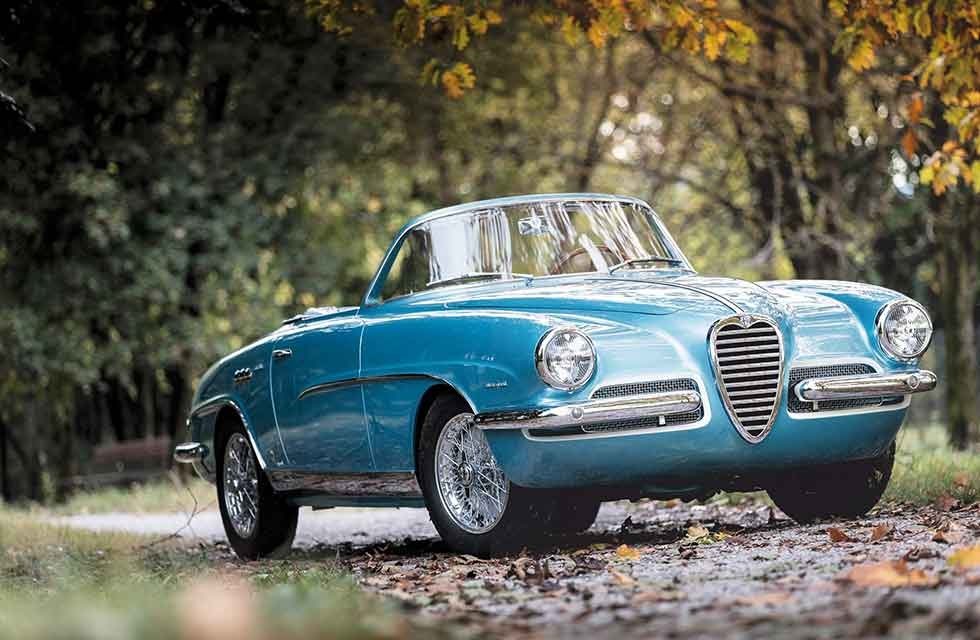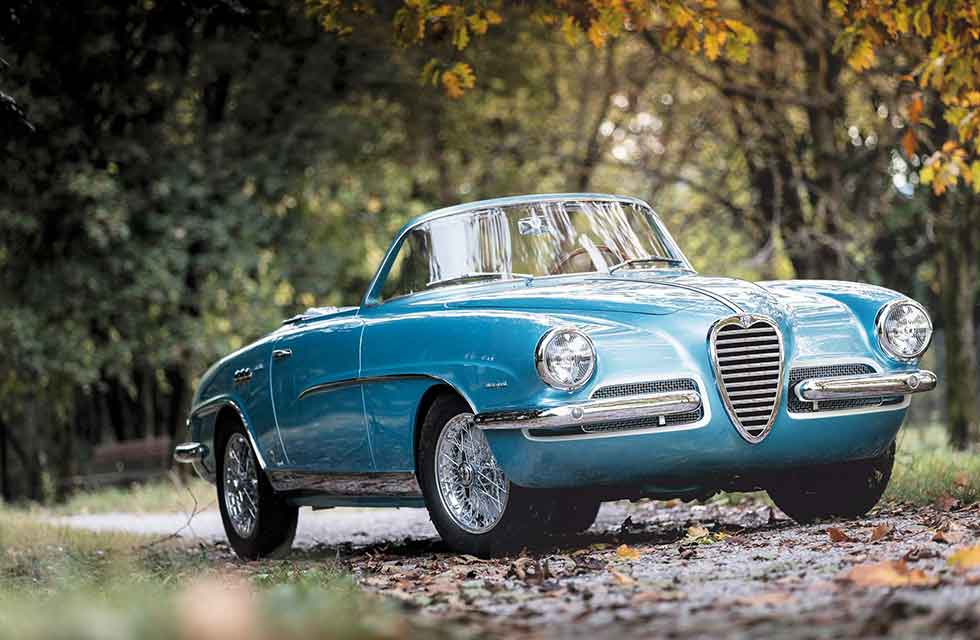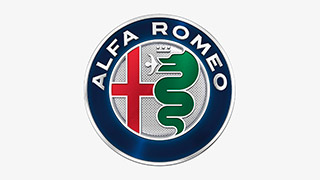
Expresso Americano A dream Italian drive in the one-off Michelotti Alfa Romeo La Flèche prototype, a meeting of Latin and American design schools. Designed by Michelotti and built for 1955’s Turin Motor Show, Alfa Romeo’s ‘La Flèche’ one-off is an intoxicating mix of nascent Italian/American styles of the time, poured over a 1900 Super Sprint. Words Rob Scorah. Photography Adam Shorrock.
Alfa La Flèche show car test
Detroit meets Milan in Michelotti’s sublime Alfa Romeo La Flèche roadster…
Oh! Now that is pretty. Yes, Okay, I know that comment is rather a cliché when talking about almost any Alfa Romeo roadster of the Fifties and Sixties, and certainly not the most profound observation when looking at a motor show one-off. But, coming from someone whose favourite colour of Fender Stratocaster is Lake Placid Blue, and also a fan of early Corvettes, that is the best you’re going to get. So, I say again; this thing – incidentally the Giovanni Michelotti-designed 1955 Alfa Romeo 1900C SS Cabriolet Turin Motor Show car – is damn pretty. When I’m sitting in it and not just gazing at it, my thoughts become largely more Alfa-esque again; there’s the three-spoked wood-rimmed steering wheel with its cross and serpent-crested boss for a start. The slender gearstick is less than a snatch away from the wheel’s circumference. And then there’s those close-together, hard-by-the-transmission-tunnel European-style pedals. If I blip the throttle, the engine responds immediately – broiling up from its growling four-pot simmer with a thrashy Italian exhaust rasp. Close my eyes and I could be in an Alfa 1900.

Well actually, I am in an Alfa 1900 – a Super Sprint. I know that because it says so on the nose. But, if you follow the trail of chrome – this car’s quite big on chrome – it takes you down the side of the body, past the door handle to just before those three… er…exhaust jets… brake vents..? Well, before those, you’ll see it also says ‘La Flèche’, which means ‘The Arrow’ in English.
La Flèche wasn’t exactly a concept car; as previously noted, it was built on to the mechanicals of the very real-world 1900. It was more of a treatment if you like, mixing influences and toying with ideas of where the model range might go – both in terms of driving style, and of exports perhaps.
And here’s where things start to get rather interesting with this car. I’m driving down a tree-lined road in Lombardy, bluehazed mountains in the middle distance, the motor burring along in its mid-tenor song, in the 2000-and-something rpm that keep the cabriolet at decent country road speeds. My hands and feet are definitely feeling Alfa 1900, but my head is still slightly somewhere else; somewhere the outward appearance of this cabriolet has put me. It’s all that chrome and the colour; several shades lighter than Lake Placid Blue (or what would have been the Corvette equivalent – Pennant Blue). The effect, and probably the reference, is deliberate of course – something that Alfa Romeo and Michelotti purposefully intended. And I think that slight Americano feel – loping along, cruising, is self-induced, not necessarily the car’s inherent character.

A blip of throttle and a characteristically smooth three-two downchange wakes the roadster up and brings me firmly back into an Italian frame of mind. La Flèche immediately picks up the pace. And that should be no surprise; by the time La Flèche was rolled on to the Turin stage in 1955, the underpinning 1900 had gone through several Sprint and Super Sprint upgrades – bored out cylinder block, better breathing and bigger brakes. In the ’1954 1900TI Super, the 1975cc engine kicked out 115bhp.
Okay, it’s not some flat-head V8 or the like, but the motor certainly feels like it’s ‘up for it’. It’s not hooked up to one of those drivetrains where you just floor the throttle to blast away, however. You’ll want to work those gears; they don’t spool out through single to triple-digit road speeds. Still; almost wherever I am in the rev range, I know I can drop a cog and tap into a thick band of torque that will push the car, nose up, down the road. This isn’t some humdrum saloon in a party frock (though sometimes the chrome flashing in the sun makes me wonder).
With any flashy-looking show car, it’s an easy cliché to talk about pedestrian or humble underpinnings, but really the 1900 was neither. The new model of 1950 was quite a milestone in Alfa Romeo’s evolution. To survive in a changing post-war world, the nationalised manufacturer, which had produced (at least some) cars and aircraft throughout the war, needed to move to mass production. The slender and sober monocoque-bodied 1900 was, if not a car for the masses, at least one of wider appeal.
Alfa intended to retain the romance and quality the Cross and Serpent had represented. And the sportiness too; one of the 1900’s marketing slogans translates as something like ‘the family car that can win races’. In saloon and coupé form, the model would be a frequent competitor in such events as the Tour de France, the Mille Miglia and even (with factory support) the 1952 Carrera Panamericana. TI stood for Turismo Internazionale.
I’ve no trouble believing that. On double wishbone front suspension – though with a rigid rear axle – the car knows how to handle itself. As curves approach, a slight brake and downchange will hold the machine in check, the weight pushing into the nose, turning the car into the bend more keenly. The pedals are so carefully placed, transitions are seamless – a little throttle, a little more, the weight flowing back through the car with a slight lean out of the curve. I’m sure you could let just the throttle choose the exit angle out of the bend butwell, itwouldn’t be appropriate to try.
The only (physical) aspect that holds back this car’s performance is the steering. It’s simply too vague, especially in the straight-ahead position, and there’s too much hauling and pulling in the tightest of turns, though the chassis and the drivetrain still manage to keep you in that road rally state of mind.
Talking of mental conditioning, the physical sensations of driving La Flèche might quickly overpower aesthetic preconceptions, but that’s not to say they aren’t still there. Looking around the cabin, I’m still getting mixed messages.
I’m sitting Fifties Ferrari barchetta-style – probably a bit too close to the wheel to get enough purchase in the tighter turns, with knees bent and ankles a little too acutely angled. The seats are relatively big for the car (I’d have liked buckets) and flat. What makes the interior something really to savour is its lack of over-restoration. This is how it left the workshop and the Turin show – plus a few cracks, scratches and wrinkles, of course. It’s like your oldest pair of never-to-be-thrown-away driving gloves.
But the big seats – with sturdy leather grab handles on the back – and the sparse but slightly baroque door furniture are giving me a faint ‘personal luxury vehicle’ vibe. This is not something that I would normally associate with Italian cars, nor particularly Giovanni Michelotti. The chromed plate fixed with two big flat-head screws on the dashboard bears his initials – tasty.
If I think of the Turin master’s other cars of the era – and he did a lot of cars – I mostly think of clean lines and ‘What makes the interior something to savour is its lack of over-restoration. This is how it left the workshop’ sparse detail. Think of the 1952 Siata 208 Spider for Bertone – a proto-AC Cobra in its wings and haunches if ever there was one. Or the 1953 Ferrari 625TF Berlinetta for Vignale, with authentic wing vents. Maybe I’m being selective; but look at the later cars for Jaguar and Ferrari with wide, flat noses – or the 1958 Triumph Zest prototype… Okay, the Herald is a bit fussy.
But La Flèche? Well, here I don’t think we’re seeing Michelotti as Michelotti. I think we’re seeing him as the agent of two slightly kitsch but complex aesthetics that swirled like a huge weather system, gaining momentum over two decades and two continents – going from the Old World to the New, and back to the Old.
There’s one interior-cum-exterior feature of this Alfa that keeps catching my eye, and which hints at it most strongly. After the grille, it was the thing I noticed most – the windscreen. It’s simple enough; a single piece of glass, steel rimmed, almost aero screenlike in profile, although bigger, beefier. But it echoes other windscreen profiles too; that of Harley Earl’s Chevrolet Corvette, which debuted at the 1953 New York Motorama, and the Lancia Aurelia Spider, unveiled a year earlier.
That feature alone of La Flèche manages to bind everything below it into a cohesive reference to Italian sports cars and those new American translations of the concept, though the chrome-over-mesh grille details do a good job of referencing other Americana – say, the Fifties Mercury Monterey.
Also, in a strangely pre-empting feature, the raised chromed blade that sweeps across the Alfa’s wing almost gives the impression of a scalloped side – a stylistic touch that would grace the Corvette a year or so hence.
But looking at all three windscreens again, they reference a deeper influence – one that was sweeping in from the States. Look again at those compound radii in the glass, the general profiles. Then have a look at, say, the canopy of the F86 Sabre fighter jet.
The Jet Age was sweeping in from North America; high speed, big power and a reinterpretation of aerodynamic forms beyond that which had excited Art Deco designs in the pre-war years. Alfa wanted – needed – to be part of that, both to influence its home customers as well as to compete in the States itself.
Slightly ironically, both the early ’Vette and Thunderbird are more minimal, cleaner, than the Italian car, which infuses a somewhat fussier, slightly hot-rod aspect. Looking at La Flèche side on, there’s an almost jet wing cross-section inferred in its profile – flat-bottomed with a faint compound curve arcing over the front and sweeping over the car in a falling line. There’s certainly visual momentum. But something in those chrome details can fool you into thinking that the back is slightly ‘jacked up’. Its not hard to imagine it sitting on slots or American Racing five-spokes, blapping side pipes below the doors. Would there have been a place for it in the US?
Within a year or so, the Corvette would gain its psychologically all-important V8 – an American tuner’s must-have. And if La Flèche were to compete in the upper echelons of US society, it might meet a form of shadow-self – perhaps the bespoke Cunningham C3 Cabriolet which, like the Alfa, was Vignalebodied (along with quite a similar interior) and itself a reworked Michelotti design (for Ferrari). The Cunningham too hid a V8, a Chrysler, under its long ‘hood’.
But Alfa knew that other trends were afoot. The firm itself was ‘downsizing’ its staple model yet again – the Giulietta was being introduced. And while America couldn’t quite bring itself to trust a mid-sized motor, it was very taken up with an older British and European tradition that had transplanted itself with returning servicemen – that of the small sports car, when it came to both driving and racing them. Alfa’s US importer Max Hoffman was, at around this time, urging the Italian manufacturer to produce such a car. In 1955 it would offer him the Pinin Farina-designed Giulietta spider. With its 1290cc engine it was slightly smaller and chubbier than La Flèche, with a wheelbase of 2250mm. Coincidentally, with a slightly longer wheelbase of 2500mm, the 1900-based model was only 91mm off that of the Thunderbird.
So La Flèche was destined to be a one-off and to lead a pretty sedentary life in the country where it was created. The film industry friendships of its third owner who lived in Rome brought it a roll-on part in a couple of movies, but these came more from association than the car’s own presence – interesting though it was alongside a line of other more obvious classics. After that, the quiet life returned, with long periods of indolence punctuated by the occasional concours appearance.
Like all one-off motors, whatever the real developmental intention of their time, it’s always interesting to ponder the what-ifs and maybes, as well as to consider what we’d change and what we’d keep of the design.
When it comes to such suggested alterations, I think I’d have to lose the three shell-like faux vents behind the doors – although in one of Michelotti’s drawings they look as if they might be turned the other way. Vents to the rear brakes? That would look a lot more purposeful. And in that same sketch, perhaps the car is wider. Maybe it could be three inches broader and a couple of inches lower? But there are enough perfectly-proportioned Alfa convertibles by Touring or Pinin Farina without changing this one. Would I give it a V8?
As the road arcs towards a distant line of poplar trees, I give the pedal one last push, letting the motor wind itself up… braaahvuuur- raaah… its a great tone, its chatter and bark more florid and colourful than any V8 – entertaining though they are, of course. It’s a soundtrack that suits La Flèche more. Its a con brio cabriolet rather than a redline roadster.
Still, it can handle spirited driving – and handle it well, at that. And I’d certainly rather take it into the mountains nearby than the more ‘authentic’ two-speed auto Corvette. Though maybe not over a Lancia Aurelia Spider…
Despite the slightly mannered appearance and the frills, La Flèche retains its identity. This car feels like a proper thing. It works. And it remains true to its Italian roots.
RESTORING LA FLÈCHE
Italian architect and unique car collector Corrado Lopresto originally saw La Flèche in a magazine some eight years ago. ‘I spoke to the photographer and asked him who the owner was,’ he remembers. He told me the owner was an important pharmacist in Forlì, but that he didn’t remember the name.’ So Lopresto simply decided to call every pharmacist in the town until he found the right one; which he eventually did.
‘I raced over to Forlì and closed the deal after seeing the car in the flesh. The interior was fantastic, but the nose was a little damaged.’ As with other cars in his collection, Lopresto was keen to maintain the integrity of the original car. He has been recognised and awarded by FIVA (Fédération Internationale des Véhcles Anciens) for his thoughtful recommissioning of classic cars.
La Flèche was repaired and refreshed by experts at Carrozzeria Airaghi in Milan. ‘The nose was straightened without being replaced,’ confirms the collector. ‘I want to maintain the original condition of my cars. I don’t want perfection.’
TECHNICAL DATA FILE SPECIFICATIONS 1955 Alfa Romeo 1900SS Cabriolet ‘La Flèche’
Engine 1975cc, inline four cylinder, dohc, twin Solex 40 P11 carburettors
Max Power 115bhp @ 5500rpm / DIN nett
Max Torque 103ft lb @ 3300rpm / DIN nett
Transmission Four-speed manual, rear-wheel drive
Steering Worm and Roller
Suspension Front: wishbones, coil springs, hydraulic dampers, anti-roll bar. Rear: live axle, trailing arms, Panhard rod, coil springs, hydraulic dampers
Brakes Hydraulic drums front and rear
Weight 1005kg
Performance Top speed: 120mph; 0-60mph: 11.0sec
Value £300,000
‘What makes the interior something to savour is its lack of over-restoration. This is how it left the workshop’
Dohc four was the work of Orazio Satta Puliga Rounded chrome grille makes references to Fifties Americana. Double wishbones up front and trailing arms at the rear keep turn-in composed. Lazy steering keeps the arms busy, which is at odds with the car’s otherwise-graceful character. The sweep from the front arch pre-empted the side scallops later given to the C1 ‘Vette. La Flèche’s aeronautic styling devices might be a little fussy, but the unique barchetta tells a fascinating transcontinental story about the Fifties.
‘La Flèche wasn’t exactly a concept car; it was built on to the mechanicals of the very real-world 1900’






